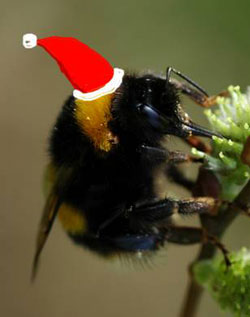Christmas Buzz

Driven by climate change, and by planting of exotic garden plants that flower through the winter, one species of bumblebee seems to have given up hibernating altogether. The buff-tailed bumblebee is a typical large yellow-and-black stripy bumblebee. Like other bumblebees, it is only normally seen from about April to September, spending the autumn and winter asleep underground. But for a few years now, confused bees have been seen in winter on the south coast of England.
This winter, the Bumblebee Conservation Trust based at University of Stirling has been sent reports of winter bumblebees as far north as Nottingham and York, suggesting that the phenomenon has spread several hundred miles northwards. It seems that, as the climate warms and winters become much milder, the bees are taking advantage and trying to breed through the year. So this year, if you feel the need for a bit of fresh air after your Christmas lunch, give the Queen’s speech a miss and go out into the garden and see if you can spot a bumblebee.
Professor Dave Goulson, of the University’s School of Biological and Environmental Sciences and the Bumblebee Conservation Trust and, said: “At a time when most of our bumblebee species are undergoing devastating declines it is good to hear that at least one species seems to be thriving, and adapting to our changing climate. However, we are concerned that there may be knock-on effects for other rare bee species. We are very keen to hear how far this has spread, and would welcome records from anyone who sees bumblebees in their garden this winter, particularly those in the North of England, Wales or Scotland.”
While the buff-tailed bumblebee is thriving, the picture is not so cheery for other bumblebee species.
Professor Goulson said: “Many bumblebee species are undergoing catastrophic declines across Europe, with three species now extinct in the UK and several more heading that way. The main cause is loss of hay meadows and flower-rich grasslands to intensive agriculture. We can all help by planting wildflowers and cottage-garden flowers such as foxgloves, lupins and lavender in our gardens.”
Professor Goulson will give a free public lecture entitled Where have our bumblebees gone? on Wednesday 13 December 2006 at 4.00 – 5.00 pm in the Logie Lecture Theatre, University of Stirling.
Media Contact
More Information:
http://www.bumblebeeconservationtrust.co.ukAll latest news from the category: Ecology, The Environment and Conservation
This complex theme deals primarily with interactions between organisms and the environmental factors that impact them, but to a greater extent between individual inanimate environmental factors.
innovations-report offers informative reports and articles on topics such as climate protection, landscape conservation, ecological systems, wildlife and nature parks and ecosystem efficiency and balance.
Newest articles

Superradiant atoms could push the boundaries of how precisely time can be measured
Superradiant atoms can help us measure time more precisely than ever. In a new study, researchers from the University of Copenhagen present a new method for measuring the time interval,…

Ion thermoelectric conversion devices for near room temperature
The electrode sheet of the thermoelectric device consists of ionic hydrogel, which is sandwiched between the electrodes to form, and the Prussian blue on the electrode undergoes a redox reaction…

Zap Energy achieves 37-million-degree temperatures in a compact device
New publication reports record electron temperatures for a small-scale, sheared-flow-stabilized Z-pinch fusion device. In the nine decades since humans first produced fusion reactions, only a few fusion technologies have demonstrated…





















